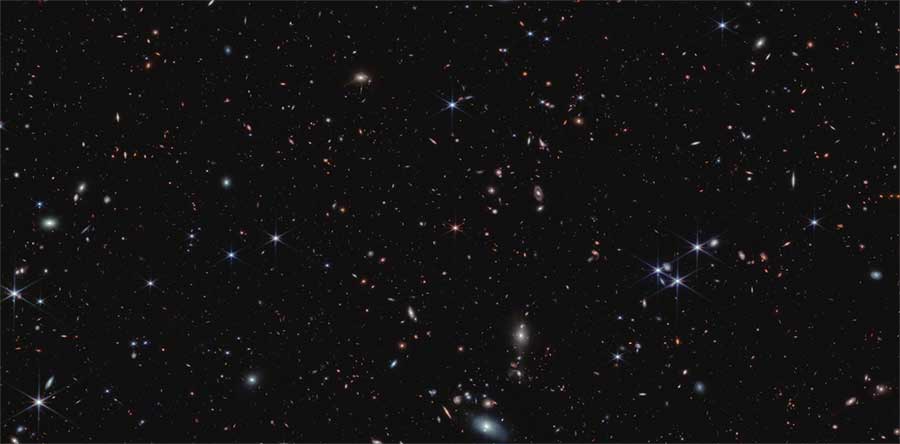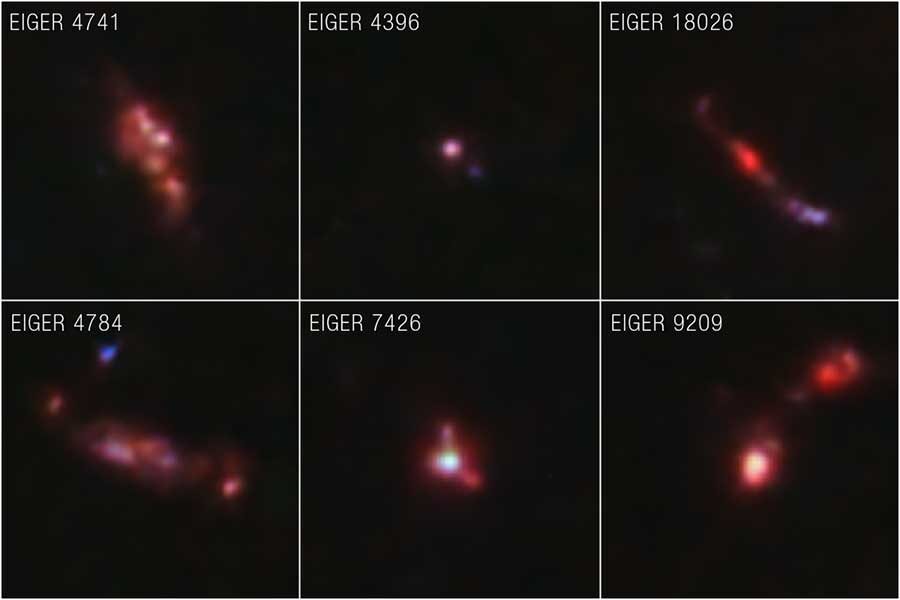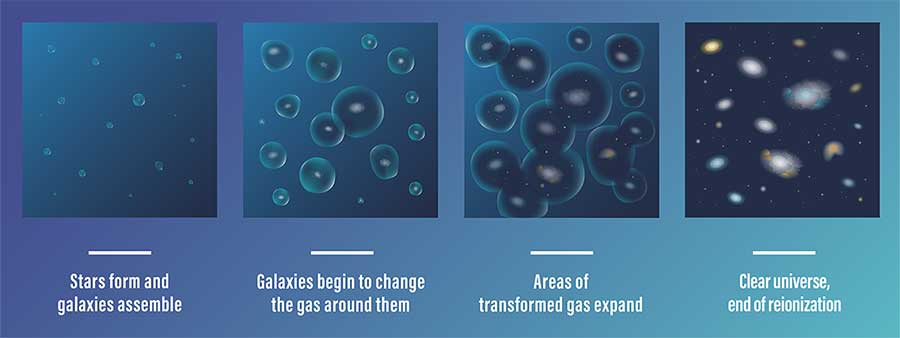New results from the James Webb Space Telescope find that radiation from ordinary galaxies cleared the primordial haze left over from the Big Bang, allowing the first light to shine through the early universe.

NASA / ES / CSA / Simon Lilly (ETH Zurich) / Daichi Kashino (Nagoya University) / Jorryt Matthee (ETH Zurich) / Christina Eilers (MIT) / Rob Simcoe (MIT) / Rongmon Bordoloi (NCSU) / Ruari Mackenzie (ETH Zurich)
In the early days of the universe, as the first stars were forming, the space between galaxies was filled with an opaque fog of neutral hydrogen. But these dark ages didn’t last. By around 1 billion years after the Big Bang, ultraviolet radiation had ionized the space between stars. The universe became transparent, and photons were free to travel the cosmos.
Until now, though, the origin of the ultraviolet light that created the epoch of reionization was still a mystery.
The EIGER Project, led by Simon Lilly (ETH Zurich, Switzerland), just published a series of three papers in The Astrophysical Journal, in which they used the Near-Infrared Camera on the James Webb Space Telescope (JWST) alongside ground-based observations from the Very Large Telescope, Magellan, and Keck Telescopes to observe one of the brightest, most distant quasars known, SDSS J0100+2802.
This quasar’s gas-guzzling supermassive black hole generates a brilliant beacon of light that illuminates the gas all along the line of sight between us and it. Astronomers can thus use the quasar to probe the state of gas around intervening galaxies — especially faraway galaxies that might be associated with reionization.
“We had the perfect complementarity of the world’s best ground-based telescopes, giving us the quasar spectrum,” Lilly says, “and the beautiful Webb, which was able to get spectroscopic data on a large number of galaxies at this very interesting epoch.”
The first study, led by Daichi Kashino (Nagoya University, Japan), reports the detection of 117 late-reionization galaxies in the line of sight between us and the quasar. We already knew that during this time period, the space between galaxies is partly hazy, partly clear. This study connects the aforementioned galaxies with transparent “bubbles” of space, where photons are able to travel freely. The further back in time toward the quasar we look, the smaller the bubbles around the galaxies appear to be.
The second study, led by Jorryt Matthee (also at ETH Zurich), characterized each of the 117 galaxies in question. They are all small, young, and chaotic, with lots of star formation and supernovae. The radiation from all this activity would have been sufficient to ionize the space around the galaxies, allowing the first light to travel freely.

NASA / ES / CSA / Simon Lilly (ETH Zurich) / Daichi Kashino (Nagoya University) / Jorryt Matthee (ETH Zurich) / Christina Eilers (MIT) / Rob Simcoe (MIT) / Rongmon Bordoloi (NCSU) / Ruari Mackenzie (ETH Zurich)
The third study, led by Ann-Christina Eilers (MIT), focused on the quasar itself, which is the most luminous quasar known in the early universe. They verified previous measurements of its mass, and they determined that it probably wasn’t gravitationally lensed — meaning it’s exactly as bright as it seems to be. (The quasar’s enormous mass so early in the universe is hard to explain, but that’s a mystery for another day).
The late-reionization space environment was already known to host lingering patches of opaque haze, interspersed with ever-growing regions where light could shine freely. But what had cleared out the transparent bubbles: brilliant quasars or ordinary galaxies?

NASA / ESA / CSA / Joyce Kang (STScI)
For a time, astronomers suspected quasars did all the work. But George Becker (University of California Riverside), who was not involved with these studies, says that idea has its own problems. “This quasar is special because it’s extremely bright, and at this point in time, it has ionized a very large bubble around it,” he explains. “But there simply aren't enough quasars out there to have reionized the whole universe by that time.”
“We suspected star-forming galaxies were mainly responsible,” he adds, “but it was unclear whether enough of their ionizing radiation actually made it out into deep space.”
Now, astronomers have shown that it’s possible. JWST’s camera has a mode that allows it to take a spectrum of every galaxy in its field of view. Using this mode, which was originally intended for calibration purposes, the EIGER team showed that the bubbles of transparent, ionized gas seen in the quasar’s spectrum were in fact associated with the exact locations of the star-forming galaxies seen by JWST. This supports the idea that ordinary galaxies did most of the work clearing the space around them.
The EIGER project is currently looking over similar data from five other quasars from this early era. And they aren’t the only ones. Becker, who’s currently leading a JWST program called “How Does Reionization End?”, summarizes his “competitors” research:
“They are providing exciting and important insight into three key questions: How the universe was reionized, how supermassive black holes formed in the early universe, and what were the properties of the first galaxies. It’s great work!”
Even though JWST has been in operation for a little less than a year, EIGER and other groups are already well placed to solve one of the biggest mysteries in cosmology. And this is just the beginning.
 11
11
Comments
Rod
June 23, 2023 at 9:10 am
A good report and summary references too. I read about this at phys.org. https://phys.org/news/2023-06-webb-telescope-galaxies-early-universe.html
My observations, no pristine gas or metal free gas is seen in the quasar light, Lyman alpha. I also note this in the phys.org report, “What do these galaxies look like? "They are more chaotic than those in the nearby universe," explained Jorryt Matthee, also of ETH Zürich and the lead author of the team's second paper. "Webb shows they were actively forming stars and must have been shooting off many supernovae. They had quite an adventurous youth!" Along the way, Eilers used Webb's data to confirm that the black hole in the quasar at the center of this field is the most massive currently known in the early universe, weighing 10 billion times the mass of the Sun. "We still can't explain how quasars were able to grow so large so early in the history of the universe," she shared.” This is pointed out in the S&T report here too. "The second study, led by Jorryt Matthee (also at ETH Zurich), characterized each of the 117 galaxies in question. They are all small, young, and chaotic, with lots of star formation and supernovae. The radiation from all this activity would have been sufficient to ionize the space around the galaxies, allowing the first light to travel freely." My note (phys.org language), *more chaotic*, and *shooting off many supernovae* is needed to explain the metals seen in the gas, a SMBH confirmed some 10 billion solar masses, and difficult to explain how quasars formed and grew so large, so early in the BB model for the expanding universe. The gas seen still contains metals and is not pristine gas from the postulated BBN and before the CMBR is said to evolve or metal free gas that is pristine from the cosmic dark ages after the CMBR is said to form.
You must be logged in to post a comment.
Andrew James
June 25, 2023 at 1:43 am
I'm having difficulty understanding your point here.
It is clear that the first stars were very large and massive, and because of this didn't last long. These are the Population III stars. The process of rapid nucleosynthesis combined with them exploding as supernovae [or some collapsing as black holes] quickly generated the metals. I'd think intermixing by the high SFR [star formation rate] was enough to pollute the pristine gas for us to see it. Moreover the density profile of the star formation regions were more compact then compared to today's density - behaving like exploding firecrackers when placed altogether in a box.
Furthermore, the these galaxies should appear chaotic, because gravity did not have the time to form the structures as we see galaxies today.
You must be logged in to post a comment.
Brian of DRAA
June 27, 2023 at 4:15 pm
I don't think we'll ever see pristine hydrogen (and 15% helium) stars; in the young universe they typically were massive (due to the lack of cooling typically supplied by the metals in Pop 2 and Pop 1 stars) and went supernova in a few million years. Any smaller Pop 3 stars, i.e. red dwarfs, that are part of the Milkyway galaxy, would have some contamination from neighbours going supernova (SN) and contaminating them. JWST may find SN remnants that are contaminated by the right amount of metals to indicate that they were pristine, Pop 3 stars when formed (see Arwen Rimmer's Oct 2022 article "TENTATIVE EVIDENCE OF THE FIRST GENERATION OF STARS"). GIAI has identified thousands of nearby stars with low metal concentrations, but never pristine.
I hope JWST catches light from an AGN that is accreting pristine gas - that would be a pretty good indication of direct collapse black holes. Note: the black hole would be there before the galaxy formed so not a real AGN. This might also be an indication of Omega = 1 (gas with little density gradient to separate a region that will form a BH from the neighbouring patch that was slightly less dense and formed Pop 3 stars).
Regardless, I know JWST will continue to surprise and astound me. Thanks for the article.
You must be logged in to post a comment.
Andrew James
June 30, 2023 at 5:01 am
Saying that; "Any smaller Pop 3 stars, i.e. red dwarfs, that are part of the Milkyway galaxy, would have some contamination from neighbours going supernova (SN) and contaminating them.” is not quite correct. Pop III are in fact only theorised as hydrogen powered stars from the initial gas. Red dwarf stars would not constitute such populations, and these would be hydrogen deficient Pop Ii stars. Current theory says that Pop III need to be very big and not like normal stars, and what they do is burn the hydrogen gas very quickly. Theoretically, these stars had to be very large because to burn the gas was extremely efficient. Unlike Bondi stars at least theoretically, what happens is the metals contained within modern stars have other metals, which by contamination, influence the gas reactions i.e. slowing them down. I don't think many astronomers these days consider that Pop III can be small massed objects.
However, one thing is quite certain in your comment is that the JWST will certainly give us more surprises in the future. Perhaps you're right, but theory is all we have at the moment. The proof of the pudding is in the eating (or the oven.)
You must be logged in to post a comment.
Andrew James
June 30, 2023 at 5:07 am
Ah. Oops! Being far too Australian... Bondi is a beach. I meant to say 'today's'. Sorry.
You must be logged in to post a comment.
Brian of DRAA
July 1, 2023 at 10:11 am
AJ, thanks for the comments, when I said "red dwarfs" I actually meant any star of less mass than the sun, that is a star that will burn for more than 13.8 billion years (types K and M). Please see "Methuselah star" as an example of a 0.8 solar mass early star ( https://en.wikipedia.org/wiki/List_of_oldest_stars ). The lack of cooling will allow Pop III stars to be huge, but lower density gas on the outside of the main cloud and turbulence inside the protostar accretion disk will will allow smaller Pop III stars to form in a binary system. The big star would have gone supernova quickly and the K or M star would get metals from that event.
You must be logged in to post a comment.
Martian-Bachelor
July 2, 2023 at 10:12 pm
> an opaque fog of neutral hydrogen
What is this about?
I thought the universe became transparent *after* the era of recombination, when it was no longer ionized. This is supposed to be the origin of the cosmic microwave background radiation. Before that the plasma was opaque because the sea of charged particles interacts strongly with light and scatters it.
But now it's the *neutral* universe which is opaque, and the universe only becomes transparent after being made ionized? This seems to flip everything on its head. Where, then, did the microwave background originate under this new model of things?
You must be logged in to post a comment.
Brian of DRAA
July 5, 2023 at 8:57 am
MB, I agree this is confusing and I had the same issue. Note the timeline too.
The CMB was established at 380,000 years after the BB (big bang) when the plasma cooled to neutral H and He. My understanding is that the CMB light has travelled in a straight line sense then until detected by Wilson and Penzias (and COBE and WMAP and Planck and my TV set). This occurred at 0.000380 Billion years, not 1 Billion years as stated in this article. How can the CMB travel through space if it was opaque for ~1 Billion years? I also thought the dark ages ended when the first stars were born, which was about 400 Million (0.4 Billion years) post BB (new discoveries from Webb aside) not when the space between galaxies became ionized. I hope we get clarification.
You must be logged in to post a comment.
Brian of DRAA
July 5, 2023 at 9:35 am
Also, the almighty Wiki says:
The first phase change of hydrogen in the universe was recombination, which occurred at a redshift z = 1089 (379,000 years after the Big Bang)...
The second phase change occurred once objects started to condense in the early universe that were energetic enough to re-ionize neutral hydrogen. As these objects formed and radiated energy, the universe reverted from being composed of neutral atoms, to once again being an ionized plasma. This occurred between 150 million and one billion years after the Big Bang (at a redshift 20 > z > 6). At that time, however, matter had been diffused by the expansion of the universe, and the scattering interactions of photons and electrons were much less frequent than before electron-proton recombination. Thus, the universe was full of low density ionized hydrogen and remained transparent, as is the case today.
I hope this is helpful.
You must be logged in to post a comment.
Andrew James
July 7, 2023 at 5:01 am
Q. "...an opaque fog of neutral hydrogen.” So what's the actually density of the fog? Surely, whilst it is true that the photons were freed making the CMB does not necessarily mean when the first stars were formed. It was the neutral hydrogen that formed the first stars as Pop III's. It was only then when the stars started to shine, by their ultraviolet radiation, that the hydrogen gas became the empty spaces between the stars. How large structures were formed occurred after this and after 1 billion years you would expect the first galaxies to be able to form into the structures that we eventually see. Clearly hydrogen without stars is just a vast cloud as a fog that had no structure nor form. The question is focused mostly on the fact that if this constitutes a fog. I leave that idea to you and the earlier comment.
You must be logged in to post a comment.
Brian of DRAA
July 16, 2023 at 12:02 pm
A.J., not certain of this, but I think the CMB and its anisotropy is a reflection of the Quantum Mechanics (QM) fluctuations of the Inflation era (10 exp -35 seconds of the big bang (BB)) and those gradients are the commencement of the large scale structure of the universe (galaxy filaments and voids). So, the large scale structure actually started in the first second of the universe. The higher density regions (hot parts of the CMB) have been gathering hydrogen (etc) ever sense. I think the "reionization" occurs at first light (typically stated as being 400 million years post BB), but by then the voids had expanded to clear out avenues for the CMB and star light to stream free to earth and the JWST. I recall reading that only 10% of the CMB microwave radiation has been scattered or absorbed by the intervening dust, gas and structures between the time it was released and now. Alan Guth’s book “The Inflationary Universe” is a fabulously insightful read about his inflation theory and Hawkings QM fluctuations that influenced the CMB anisotropy and the large scale structure of the universe we see.
You must be logged in to post a comment.
You must be logged in to post a comment.